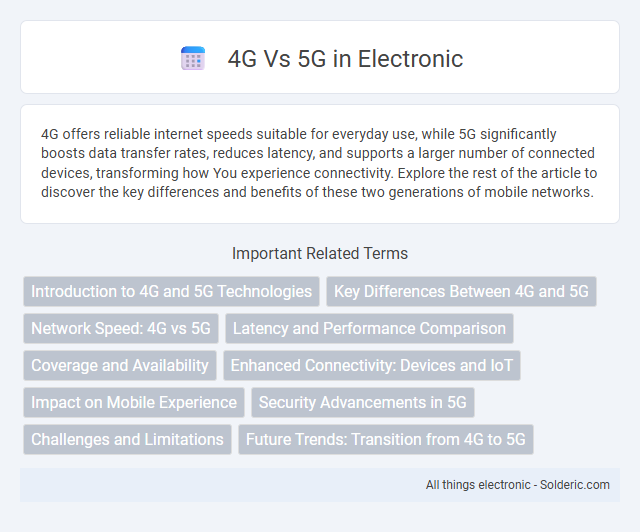4G offers reliable internet speeds suitable for everyday use, while 5G significantly boosts data transfer rates, reduces latency, and supports a larger number of connected devices, transforming how You experience connectivity. Explore the rest of the article to discover the key differences and benefits of these two generations of mobile networks.
Comparison Table
| Feature | 4G | 5G |
|---|---|---|
| Maximum Speed | Up to 1 Gbps | Up to 20 Gbps |
| Latency | 30-50 ms | 1-5 ms |
| Bandwidth | Up to 100 MHz | Up to 400 MHz and higher with mmWave |
| Frequency Bands | 600 MHz - 2.5 GHz | 600 MHz - 52.6 GHz |
| Technology | LTE, OFDMA | NR (New Radio), Massive MIMO, Beamforming |
| Number of Connected Devices | Up to 100,000 devices per km2 | Up to 1 million devices per km2 |
| Use Cases | HD streaming, mobile internet, VoLTE | IoT, autonomous vehicles, smart cities, AR/VR |
| Deployment | Widespread globally since 2010s | Rolling out globally since 2019 |
| Power Efficiency | Moderate | Improved for IoT and mobile devices |
Introduction to 4G and 5G Technologies
4G technology revolutionized mobile communication with high-speed internet and improved connectivity, enabling HD streaming, video calls, and mobile gaming. 5G technology significantly advances these capabilities with ultra-fast data speeds up to 10 Gbps, minimal latency below 1 millisecond, and enhanced network capacity supporting massive IoT device integration. Understanding the differences between 4G and 5G helps you leverage superior performance and future-proof your digital experience.
Key Differences Between 4G and 5G
5G offers significantly higher data speeds than 4G, reaching up to 10 Gbps compared to 1 Gbps on 4G, enabling faster downloads and seamless streaming. The latency in 5G is drastically reduced to around 1 millisecond versus 30-50 milliseconds in 4G, enhancing real-time applications like gaming and autonomous driving. Additionally, 5G supports a higher density of connected devices per square kilometer, making it ideal for the Internet of Things (IoT) and smart city deployments.
Network Speed: 4G vs 5G
5G networks deliver significantly faster speeds compared to 4G, with peak data rates reaching up to 10 Gbps, roughly 100 times faster than 4G's maximum of 100 Mbps. This enhanced network speed enables ultra-high-definition video streaming, real-time gaming, and seamless connectivity for numerous IoT devices simultaneously. Your experience will vastly improve with 5G's lower latency and increased bandwidth, supporting more demanding applications than 4G ever could.
Latency and Performance Comparison
5G technology offers significantly lower latency than 4G, reducing delays to as low as 1 millisecond compared to 30-50 milliseconds in 4G networks, which greatly enhances real-time communication and responsiveness. Performance in 5G is substantially improved with peak data rates up to 10 Gbps, surpassing 4G's maximum of around 1 Gbps, enabling faster downloads and smoother streaming. Your experience with 5G will involve quicker network responses and higher bandwidth that support advanced applications like augmented reality and autonomous vehicles.
Coverage and Availability
4G networks provide extensive coverage with widespread availability in urban and rural areas, while 5G coverage is currently limited to major cities and dense urban environments due to ongoing infrastructure deployment. 5G's higher frequency bands, such as mmWave, offer faster speeds but have shorter range and are more susceptible to obstacles, which impacts its coverage compared to 4G's lower frequency bands. Network providers are expanding 5G availability through small cell installations and spectrum reallocation to enhance coverage beyond metropolitan regions.
Enhanced Connectivity: Devices and IoT
5G technology offers significantly enhanced connectivity compared to 4G, enabling faster data transfer rates and lower latency, which are crucial for seamless device communication and IoT applications. Your smart devices and IoT systems benefit from 5G's improved capacity to handle a massive number of connections simultaneously, ensuring reliable and real-time data exchange. This advancement supports smarter cities, autonomous vehicles, and advanced industrial automation, transforming the way devices interact and operate.
Impact on Mobile Experience
5G technology significantly enhances mobile experience by delivering up to 10 Gbps speeds, compared to 4G's maximum of 1 Gbps, enabling faster downloads and smoother streaming. Reduced latency in 5G networks, as low as 1 millisecond versus 4G's 50 milliseconds, improves real-time applications like gaming and video calls. The expanded bandwidth and network capacity of 5G support more simultaneous connections, ensuring stable service in crowded areas.
Security Advancements in 5G
5G technology introduces enhanced security protocols such as network slicing and improved encryption algorithms that significantly reduce vulnerabilities compared to 4G. It employs advanced authentication methods like enhanced subscriber identity protection and mutual authentication between devices and network components. These security advancements address 4G limitations by providing stronger defense against cyberattacks and ensuring more robust privacy for users and IoT ecosystems.
Challenges and Limitations
5G technology faces challenges such as limited coverage area, high infrastructure costs, and complex deployment processes compared to 4G. Network compatibility issues with existing 4G devices and concerns about energy consumption also limit widespread adoption. To optimize your connectivity, understanding these limitations helps in managing expectations during the transition to 5G networks.
Future Trends: Transition from 4G to 5G
The transition from 4G to 5G focuses on significantly enhanced data speeds, ultra-low latency, and massive device connectivity supporting IoT expansion. 5G networks utilize advanced technologies like millimeter waves, massive MIMO, and network slicing to enable smart cities, autonomous vehicles, and remote healthcare applications. Global 5G adoption drives infrastructure upgrades and spectrum reallocation, accelerating the evolution toward more intelligent, seamless wireless communication ecosystems.
4G vs 5G Infographic

 solderic.com
solderic.com